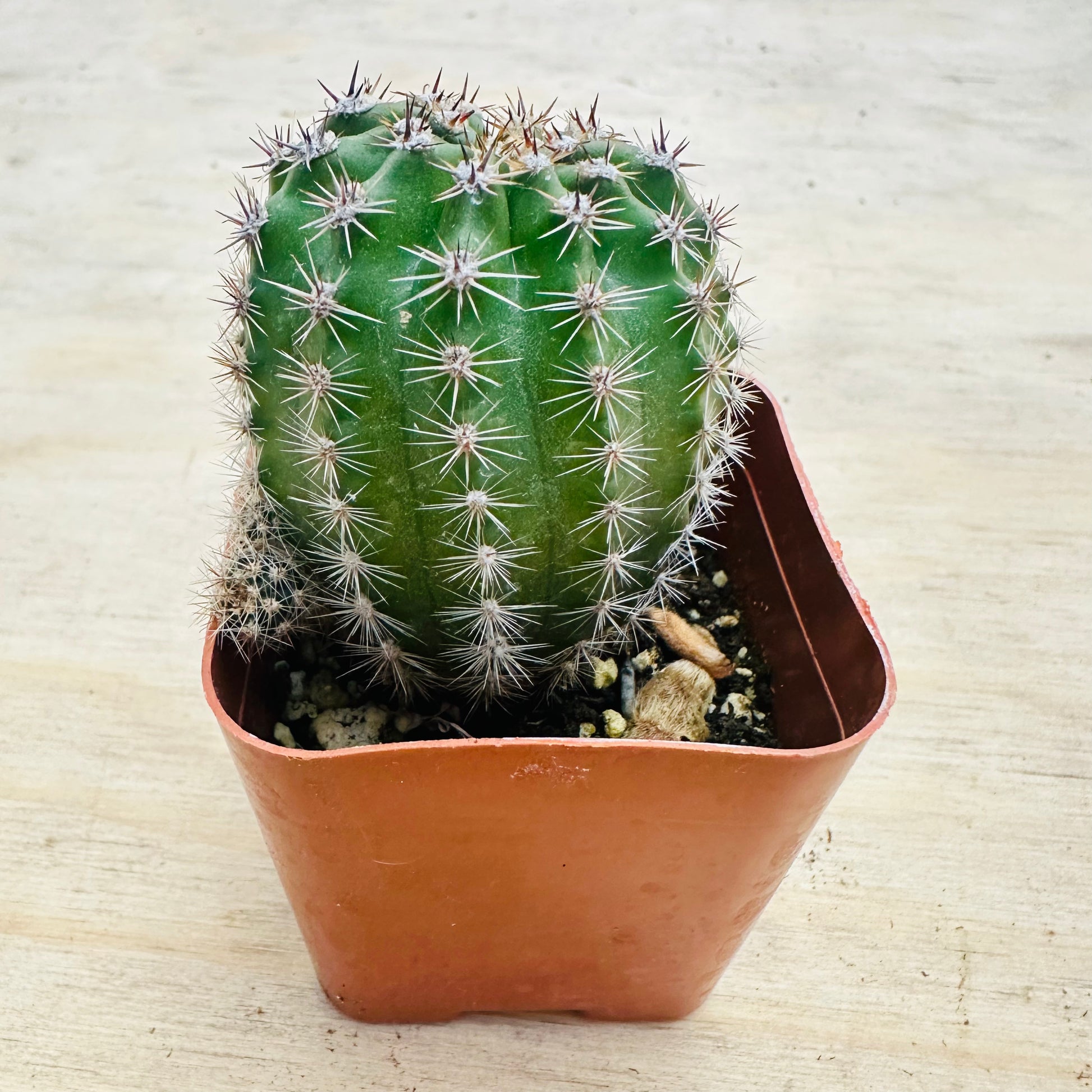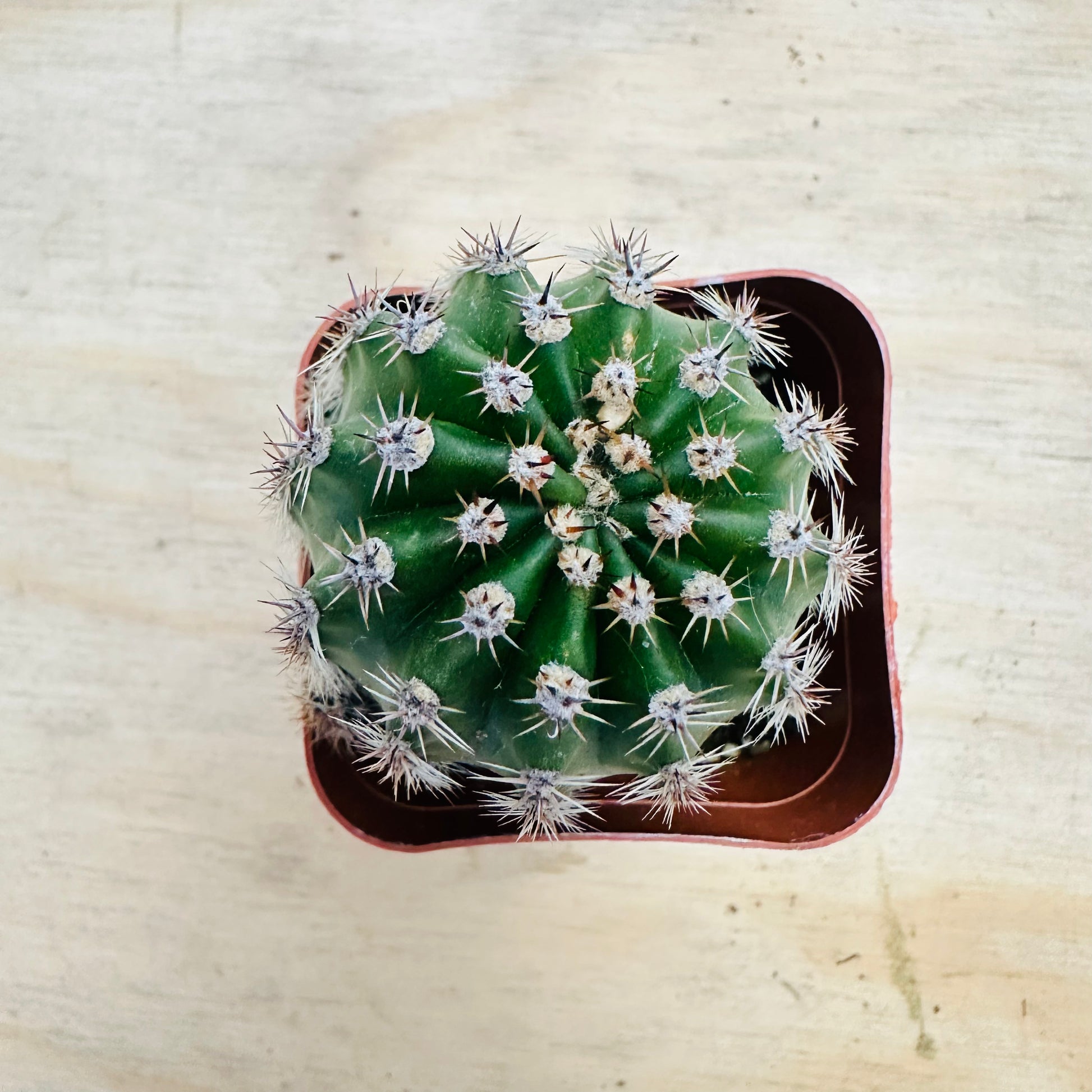Echinobivia - Rainbow Bursts
Echinobivia - Rainbow Bursts
In stock
Couldn't load pickup availability
📝 Description
**Morphological Characteristics**
Echinobivia, commonly marketed under the name "Rainbow Bursts," is a popular hybrid genus resulting from a cross between Echinopsis and Lobivia cacti, both belonging to the Cactaceae family. This hybrid combines the compact, rounded form of Lobivia with the vivid, large flowers typical of Echinopsis, creating a plant that is both visually striking and easy to care for.
The body of Rainbow Bursts is typically globular to short-columnar, with a diameter of 5-15 cm (2-6 inches). It is green to dark green in color, with well-defined ribs lined with evenly spaced areoles. From each areole, short, fine, white to yellowish spines radiate, giving the plant a slightly fuzzy appearance without being overly prickly. During the blooming season, which typically occurs in late spring through summer, Rainbow Bursts produce stunning, funnel-shaped flowers in an array of vibrant colors such as red, orange, pink, yellow, and sometimes multi-colored blends. The flowers are large compared to the plant, often reaching 8-12 cm (3-5 inches) in diameter.
**Growth Habits**
Rainbow Bursts are moderate growers, forming single plants that may cluster with age. Their compact size and prolific flowering make them ideal for small pots, rock gardens, and window displays. Given the right conditions, they can bloom multiple times throughout the growing season, rewarding growers with vivid floral displays.
**Maintenance Points**
• Lighting: Prefers bright, indirect light to full sun. Outdoors, it should be placed where it receives morning sun and some protection from harsh afternoon rays. Indoors, a south-facing window is ideal.
• Watering: Water deeply but infrequently. Allow the soil to dry completely between waterings. In the dormant winter period, water very sparingly, just enough to prevent shriveling.
• Soil: Use a well-draining cactus or succulent mix. Enhance drainage with coarse sand, pumice, or perlite.
• Temperature: Thrives in temperatures between 18-30°C (65-86°F). It can tolerate short periods of near-freezing temperatures if kept dry, but it is best to protect it from frost.
• Fertilization: During the growing season (spring and summer), feed monthly with a diluted, low-nitrogen cactus fertilizer to encourage flowering. Avoid fertilizing during dormancy.
• Potting: Ensure pots have excellent drainage. Repot every 2-3 years in early spring to refresh the soil and promote healthy growth.
• Humidity: Prefers low humidity environments. Good airflow helps prevent fungal issues.
**Reproduction Method**
Rainbow Bursts can be propagated by offsets and seeds.
1. **Offsets:**
• Selection: Gently remove small pups that form at the base of the parent plant.
• Callusing: Allow offsets to dry and callus for a few days before planting.
• Planting: Set the callused offset into a well-draining cactus mix and water lightly.
• Aftercare: Place in bright, indirect light and keep soil barely moist until roots establish.
2. **Seeds:**
• Sowing: Sow seeds on the surface of a sterile, well-draining seed mix.
• Germination: Maintain slightly moist soil and temperatures between 21-27°C (70-80°F). Germination may take several weeks.
• Transplanting: Move seedlings to individual pots once they are large enough to handle.
**Additional Tips**
• Flowering Encouragement: To encourage blooms, provide bright light, a well-regulated watering schedule, and a cool, dry dormancy period in winter.
• Pest Control: Watch for pests like spider mites, mealybugs, and scale insects. Treat promptly with neem oil or insecticidal soap.
• Disease Prevention: Avoid overwatering and provide excellent drainage to prevent root rot.
• Display: Their vibrant flowers and compact size make them excellent for container gardens, patios, and indoor sunrooms.
With their dazzling floral displays, manageable size, and relatively easy care, Echinobivia - Rainbow Bursts are a delightful addition to any succulent or cactus collection, perfect for gardeners seeking both color and character.
🌿 Care Tips
Plant Care
Light
Water
Soil
Temperature
🌟 Note: It’s normal for succulents to appear slightly shriveled after shipping. They usually recover within a few days in a suitable environment.
📦 Shipping Info
Seah Shipping Policy
Effective Date: November 2025
This Shipping Policy applies to orders delivered within the continental United States (the lower 48 states). By purchasing from Seah, you agree to the terms below.
1) Shipping Cost & Free Shipping
- Automatic rate calculation: Shipping is calculated at checkout based on weight, destination ZIP and carrier rates.
- Free Standard Shipping: Orders $59+ (pre-tax, after discounts) ship free to the lower 48 states.
- Alaska, Hawaii, Puerto Rico & other territories: Not eligible for free shipping or standard flat offers at this time.
- Taxes/Duties: Applicable sales tax and any fees are shown at checkout.
2) Processing Schedule
- Business days only: We process and ship Monday–Friday. No shipping on weekends or U.S. federal holidays.
- Handling time: 1–3 business days after payment confirmation.
- Cut-off time: Orders placed before 3:00 PM (PST) are prioritized for same-day processing; others roll to the next business day.
- Changes/Cancellations: Email support@seah.co within 12 hours of purchase; after that, the order may already be in processing.
3) Transit Times
| Method | Estimated Transit | Total ETA (Handling + Transit) |
|---|---|---|
| Standard | 5–8 business days | 6–11 business days |
| Express | 3–4 business days | 4–7 business days |
ETAs are estimates. Weather, holidays, carrier delays or high-volume periods may extend delivery times.
4) Seasonal Temperature & Plant Safety
- Winter (Nov–Mar): We strongly recommend adding a heat pack at checkout to protect plants from freezing. Orders shipped without a heat pack during cold conditions are not covered for cold damage.
- Summer heat: During extreme heat waves, we may hold shipments until temperatures normalize. We’ll notify you if there’s a hold.
- Packaging: Plants are carefully packed (bare-root or potted by type/size) to minimize transit stress.
5) Carriers & Tracking
- We ship via USPS / UPS / FedEx, selected automatically for best service to your address.
- When your order ships, you’ll receive a tracking email. Tracking typically activates within 24 hours.
- If you haven’t received tracking within 3 business days, contact us at support@seah.co or +1 (626)-999-1314.
6) Address Changes & Delivery Issues
- Before shipment: Request address changes within 12 hours of ordering.
- After shipment: We can’t modify the address once dispatched. Please contact the carrier for redirection options.
- PO Boxes: Supported for USPS only; UPS/FedEx require a street address.
- Seah isn’t responsible for delays or loss due to incorrect addresses provided at checkout.
7) Service Area
We currently ship to the continental U.S. (lower 48 states). Orders to AK/HI/PR and other territories are not eligible for free shipping and may be restricted.
8) Support
- Hours: Mon–Fri, 9:00 AM – 5:00 PM (PST)
- Phone: +1 (626)-999-1314
- Email: support@seah.co
- Address: 7870 Margaux Pl, Rancho Cucamonga, CA 91739, United States
Thank you for supporting our California nursery—each plant is hand-selected and packed with care. 🌱






